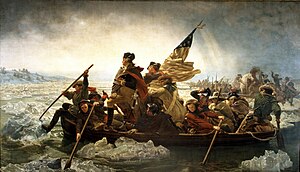Washington Crossing the Delaware

|
| Washington Crossing the Delaware |
|---|
| Emanuel Leutze , 1851 |
| Oil on canvas |
| 378.5 × 647.7 cm |
| Metropolitan Museum of Art, New York City |
Washington Crossing the Delaware ( German Washington crosses the Delaware ) is an oil painting by the German-American history painter Emanuel Leutze from 1851. It shows General George Washington's crossing of the Delaware River on the night of December 25th to 26th, 1776 during the American War of independence . This event was the first troop movement in the form of a surprise attack against the Hessian units in the Battle of Trenton , New Jersey .
The original picture was part of the collection of the Kunsthalle Bremen . It was destroyed in British air raids in 1942. It had already been scorched on November 5, 1850 in a fire in the apartment below Leutzes studio; However, Leutze had insured the picture and was able to restore it.
The French Adolphe Goupil , who had been trading in art prints on the Parisian Boulevard Montmartre in cooperation with the German Henry Rittner since 1827 and who had also entered the international art trade as Goupil & Cie from 1850, gave a visit to Leutzes Düsseldorf studio second, larger version of Washington Crossing the Delaware commissioned. For the production of this picture, Leutze set up a studio in Düsseldorf's Schadowstrasse , which offered space for at least five other painters. Under Leutzes leadership, Eastman Johnson , Worthington Whittredge and three other painters worked on the picture. A spectacular exhibition of this work in New York was obviously intended to give the Goupil branch, which opened on Broadway in 1849 under the name The International Art-Union, publicity and a clear American profile. From September 1851 to January 1852 the monumental painting was on view in the Stuyvesant Institute on Broadway. It was mostly enthusiastically received by the 50,000 visitors. “ I have no hesitation in telling you, gentlemen, that I consider Washington Crossing the Delaware to be one of the greatest works of the age. It is truly worthy to document the greatest event in the military life of the great man whom the nation adores, ”said New York collector and President of the American Art Union , Abraham M. Cozzens , at a banquet in honor of Leutzes . First, the New York shipbuilding magnate Marshall O. Roberts bought the painting for $ 10,000. It has been on display at the Metropolitan Museum of Art in New York City since 1897 . Another version is in the Minnesota Marine Art Museum .
Image composition
The painting is known for its bold composition: George Washington stands out against an unnaturally bright night sky while his face gazes into the rising sun. Immediately before Washington, a black man grabs the belt. The basic tone of the colors is dark, as is to be expected in the twilight. The men in the boat represent different people from the former British colonies that made up the United States as a Federal Republic, as well as the slaves imported from Africa by the British and Dutch. It depicts an African American , a man in a tartan hat , a rifleman from the western United States, two farmers, an androgynous person in red clothing, and a man from the indigenous population. The man standing next to Washington holding the flag is Lieutenant James Monroe , who will later become the 5th President of the United States . General Edward Hand is shown seated in the picture; he holds his hat in his hand.
The painting contains impressions of the river landscape of the Rhine near Kaiserswerth . The city of Meerbusch in the Rhine district of Neuss claims that the bank that can be seen in the background of the picture is not the bank of the Delaware, but the bank of the Rhine near Meerbusch. In 1975, in her Leutze monograph “Freedom is the only King”, Barbara Groseclose refers to a poem that Düsseldorfers recited in 1851 at the celebration in honor of Leutzes, before Leutzes set off for America with the monumental picture. The second stanza says about the Delaware:
This flows in the far west
between America and here,
and many horrific monsters live on its desert coasts
.
Accordingly, the picture is not a naturalistic rendering of a historical event in a nameable geographical location, but a symbolic picture, a work of the imagination of timeless significance.
Web links

See also
Individual evidence
- ↑ a b Ronald D. Barley : Washington crossing the Rhine . America's most popular painting and its German history. In: DIE ZEIT, No. 52 . 19th December 2013.
- ^ The Metropolitan Museum of Art Bulletin , number. 7 (March, 1968), pp. 292f.
- ^ Sabine Morgen: The broadcast of the Düsseldorf painting school to America in the 19th century. Düsseldorf paintings in America and American painters in Düsseldorf . Göttingen Contributions to Art History, Volume 2, Göttingen 2008, ISBN 978-3-7675-3059-1 , p. 410 f.
- ^ 'Washington Crossing The Delaware' art piece on display at MMAM. February 22, 2012, accessed April 2, 2017 .
- ↑ Barbara Groseclose: Emanuel Leutze 1816-1868: Freedom is the only King . Published for the National Collection of Fine Arts by the Smithsonian Institution Press, 1975, pp. 65 .